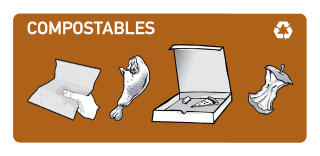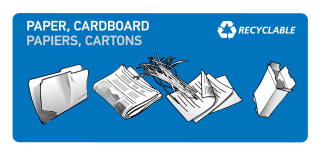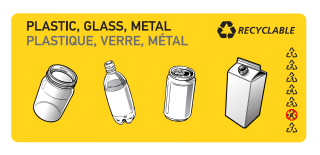At McGill, non-hazardous waste is sorted into four streams. See the tabs below for more information on how to sort your waste.
Compost (brown)

Organic materials go in the brown compost stream. Anything that once a living organism is considered an organic material, including food waste, paper products, and bamboo utensils. Here you can find a list of all the academic buildings with compost on McGill’s campuses.
| YES | NO |
|---|---|
| Food waste | Inorganic materials |
| Napkins, tissue, and paper towels (must be free of cleaning products) | Hazardous household waste (i.e., paper towel soiled with chemical products) |
| Coffee cups marked as compostable | Disposable coffee cups which are not marked as compostable |
| Soiled cardboard or paper (I.e., pizza boxes and paper plates) | Waxed or laminated plastic and cardboard (i.e., plastic-lined cardboard takeout containers) |
| Tea bags, coffee grounds, and coffee filters | Liquids |
| Bamboo utensils | Plastic marked as compostable, biodegradable, BPI, and/or #7(PLA) |
| Parchment paper | Textiles |
| BNQ-certified compostable bag | Animal waste |
| Flowers and house plants |
Paper / cardboard (blue)

Clean and dry paper and cardboard should go into the blue stream.
| YES | NO |
|---|---|
| Paper | Coffee cups (coffee cups marked as compostable can go in the compost stream, otherwise, they must go in the landfill) |
| Cardboard (flattened boxes) | Paper products stained with food or grease ex: pizza boxes or paper plates (these should go in the compost stream) |
| Newspaper | Dirty or wet paper products (if the paper is free of cleaning products, it can go in the compost stream, otherwise, it must go in the landfill) |
| Magazines | |
| Egg cartons and coffee trays |
Plastic, glass, and metal recyclable containers (yellow)

The yellow stream is for mixed recycling: Plastic, glass, and metal. For plastics, look for the Mobius triangle (triangle made up of three arrows) on the bottom to find the number. Before you place an item in the yellow stream, make sure it is clean and empty and separate the lids from your containers.
| YES | NO |
|---|---|
| Plastics #1, 2, 3, 4, 5, 7 | Plastic with no number (this must go in the landfill) |
| Metal containers (i.e., cans) | Plastic #6 (this must go in the landfill) |
| Aluminum foil (remove as much residual food as possible, then make a ball with the aluminum to contain the soiled part inside) | Plastic cutlery (this must go in the landfill) |
| Milk or juice containers (“Tetrapack”) | Coffee creamers (this must go in the landfill) |
| Glass containers | Plastic coffee creamers |
| Stretchy plastic (i.e., plastic grocery bags, clean Ziploc bags, clean plastic cling wrap) | Broken and flat glass (this must be wrapped in paper and go in the landfill or be dropped off at your local Écocenter) |
Landfill (black)

The very last option. However, remember that it’s better to throw something in the landfill than to potentially contaminate a whole bag of well-sorted recycling. If you cannot empty your container or of if you are not sure how to sort your item, when in doubt, throw it out.
| YES | NO |
|---|---|
| Any item that you are not sure about | Clean and dry recyclable plastic, glass, and metal |
| Non-compostable coffee cups | Clean and dry paper and cardboard |
| Styrofoam | Organic waste (unless there is no compost stream available) |
| Plastic #6 | Hazardous waste (see below) |
| Plastic with no number (i.e., cutlery, coffee creamers) | |
| Recyclable containers covered with food residue | |
| Metallic plastic bags and wrapping (i.e., chip bags and granola bar wrappers) | |
| Waxed paper | |
| Non-stretchy plastic bags (i.e., frozen fruit and vegetable bags) |
Hazardous Waste
Hazardous Waste Management (HWM) provides a full hazardous material disposal service to the McGill community at both Macdonald and Downtown Campus. Disposal of waste is free of charge to internal departments, provided the waste is coming from research activities and presented in a proper manner.
| YES | NO |
|---|---|
| Batteries: Battery collection bins can be found in the main areas of major buildings on both campuses, including residences. | Contact Hazardous Waste Management for any inquiries |
| Electronics: The Macdonald Campus community can bring their old computers at the University Archives before any boxes are shipped or destroyed. For other electronics contact Hazardous Waste Management |